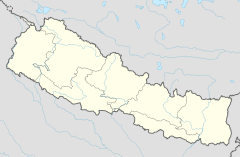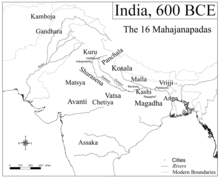Ramagrama stupa
| रामग्राम नगरपालिका | |
 King Ashoka (right) visits the Ramagrama Stupa (center), to take relics of the Buddha from the king (left), but he failed, the king being too powerful. Southern gateway, Stupa 1, Southern Gateway, Sanchi. | |
 Location of Ramagrama on map | |
| Coordinates | 27°29′52″N 83°40′52″E / 27.49778°N 83.68111°ECoordinates: 27°29′52″N 83°40′52″E / 27.49778°N 83.68111°E |
|---|---|
| Location | Parasi, parasi District, Lumbini Zone, Nepal |
| Type | stupa |
| Material | brick and earth |
| Length | 50 metres (160 ft)[1] |
| Width | 50 metres (160 ft)[1] |
| Height | 6.85 metres (22.5 ft)[1] |
| Beginning date | circa 483 BCE[2] |
| Completion date | circa 483 BCE[2] |
| Dedicated to | Gautama Buddha |
| Pilgrimage to |
| Buddha's Holy Sites |
|---|
 |
| The Four Main Sites |
|
| Four Additional Sites |
| Other Sites |
|
| Later Sites |
|
Ramagrama stupa (Nepali: रामग्राम नगरपालिका, also Ramgram, Rāmgrām, Rāmagrāma) is a stupa located in Ramgram Municipality, in the Parasi District of Nepal. This Buddhist pilgrimage site containing relics of Gautama Buddha was constructed between the Mauryan and Gupta periods, according to research by Nepal’s Department of Archaeology.[3][4]
History[]

Gautama Buddha's parents were from two different mahājanapadās (kingdoms) of the Solar dynasty — his father (Śuddhodana) belonged to the Shakya kingdom, while his mother (Maya) was from the Koliya kingdom. According to Buddhist texts, after Buddha's Mahaparinirvana, his cremated remains were divided and distributed among the princes of eight of the sixteen mahājanapadās. Each of the princes constructed a stupa at or near his capital city, within which the respective portion of the ashes was enshrined.[5] These eight stupas were located at:
- Allakappa, a settlement of the people. The precise location of this place is not currently known.[6][7]
- Kapilavastu, capital city of the Shakya kingdom[8] (the location of this stupa is the subject of some controversy; there is evidence it was actually constructed at Piprahwa)[9][10]
- Kusinārā, capital city of the Malla kingdom[11]
- Pāvā, a major city of the Malla kingdom[12]
- Rājagaha a major city of the Magadha kingdom[13]
- Rāmagrāma, a major city of the Koliya kingdom (this settlement is sometimes referred to as Koliyanagara)[14][15]
- Vesāli, capital city of the Vajji kingdom[16]
- , a settlement of Brahmins. The precise location of this place is not currently known.[17]
Some 300 years later, Emperor Ashoka opened seven of these stupas and removed the Buddha relics (his goal was to redistribute the relics into 84,000 stupas which he planned to construct throughout the Maurya Empire). According to legend, the serpent king was guarding the Ramagrama stupa, and prevented Ashoka from unearthing the relic, making it one of the eight undisturbed stupas.
Archaeological research[]
To this day, Ramagrama stupa remains the only intact and original stupa containing relics of Buddha.[3] The stupa has been an object of great reverence and pilgrimage site since its original construction. The 7-metre-high (23 ft) stupa is now buried under a mound of earth and is awaiting further research.[5] The dimensions of the stupa complex are 10m high and 23.5m in diameter. A geophysical survey revealed a perfect quadrangular Kushan monastery buried below the surface, whose dense concentration of brick prevented crops from growing, leading to the area being known as an "unlucky field".[4]
World Heritage Status[]
This site was added to the World Heritage Tentative List by UNESCO on May 23, 1996 in the Cultural category.[3]
See also[]
- Ayodhya
- Dasharatha
- Ikshvaku dynasty
- Kshatriya
- Mahapadma Nanda
References[]
- ^ a b c Shrestha, SS (2001). "Ramagrama excavation II" (PDF). Ancient Nepal: Journal of the Department of Archaeology. 148: 1–29. Retrieved 2014-11-30.
- ^ a b Cousins, LS (1996). "The dating of the historical Buddha: a review article". Journal of the Royal Asiatic Society. Series 3. 6 (1): 57–63. doi:10.1017/s1356186300014760.
- ^ a b c UNESCO (2014). "Ramagrama, the relic stupa of Lord Buddha". Tentative Lists. Paris: UNESCO World Heritage Centre. Retrieved 2014-11-30.
- ^ a b unesdoc.unesco.org https://unesdoc.unesco.org/ark:/48223/pf0000262925. Retrieved 2021-04-15.
{{cite web}}: Missing or empty|title=(help) - ^ a b Shrestha, SS (1999). "Ramagrama excavation" (PDF). Ancient Nepal: Journal of the Department of Archaeology. 142: 1–12. Retrieved 2014-11-30.
- ^ "Allakappa". Palikanon.com. Retrieved 2015-05-16.
- ^ "Bulī". Palikanon.com. Retrieved 2015-05-16.
- ^ "Kapilavatthu". Palikanon.com. Retrieved 2015-05-16.
- ^ Peppe, WC (1898). "The Piprahwa Stupa, containing relics of Buddha". Journal of the Royal Asiatic Society (Article XXIII): 573–88.
- ^ Srivastava, KM (1980). "Archaeological Excavations at Piprāhwā and Ganwaria and the Identification of Kapilavastu". The Journal of the International Association of Buddhist Studies. 13 (1): 103–10.
- ^ "Kusinārā". Palikanon.com. Retrieved 2015-05-16.
- ^ "Pāvā". Palikanon.com. Retrieved 2015-05-16.
- ^ "Rājagaha". Palikanon.com. Retrieved 2015-05-16.
- ^ "Rāmagāma". Palikanon.com. Retrieved 2015-05-16.
- ^ "Koliyā". Palikanon.com. Retrieved 2015-05-16.
- ^ "Vesāli". Palikanon.com. Retrieved 2015-05-16.
- ^ "Vethadīpa". Palikanon.com. Retrieved 2015-05-16.
Further reading[]
External links[]
- Ramgram Stupa, the Buddha relic stupa of Nepal
- Ramgram Stupa ko Behal-Nawalparsi (video in Nepali language)
- Buddhist pilgrimage sites in Nepal
- Buildings and structures in Parasi District
- Religious buildings and structures in Nepal
- Buddhist relics
- Archaeological sites in Nepal
- 5th-century BC establishments in Nepal
- Nāgas
